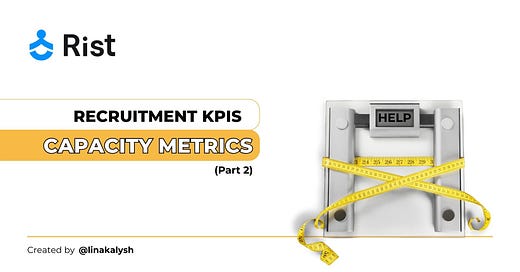Recruitment KPIs: Capacity Metrics
Part 2: Turning slide bullets into real‑world impact, data, and client wins
Part 1 of this series showed how speed metrics (Time‑to‑Fill, Time to Productivity) reveal how fast you hire.
Part 2 tackles capacity - the yard‑stick that tells you how much you can hire before quality slips or recruiters burn out.
Why read on?
• 43 % of TA leaders admit they set hiring targets with no data on recruiter workload (Gartner, 2024).
• Companies that track capacity metrics fill roles 19 days faster on average (LinkedIn Global Recruiting Benchmarks, 2025).
Capacity: What is it?
Definition. In recruitment, capacity is the number of vacancies or candidates a single recruiter – or an entire TA team – can handle effectively in a defined period.
Why it matters
Reveals the true throughput of your recruitment engine.
Flags burnout risk and hidden hiring delays before they surface.
Lets managers plan when and how many extra hands are needed.
Hidden insight: Many companies over‑estimate recruiter capacity, forgetting role complexity or ultra‑competitive markets. The result? Vacancies linger 30‑50 % longer than forecast.
Key Capacity Metrics in Recruitment:
1. Vacancies per Recruiter
What is it? The ratio of open requisitions handled by one recruiter at a given moment.
Formula
Vacancies per Recruiter =
Total Active Vacancies ÷ Recruiters Actively HiringWhy it matters: A quick test for workload balance, budget planning, and deciding whether to hire an additional recruiter or outsource.
Overlooked detail:
Complexity skews capacity: one recruiter can juggle 5 mid‑level roles but only 2–3 niche tech roles. Ignoring this doubles Time‑to‑Fill (Rist Talent internal study, 2024).
Client example: Fintech scale‑up - 35 open roles / 5 recruiters ⇒ ratio = 7. Close Rate sat at 42 %. Hiring a contract recruiter dropped the ratio to 5.8; Close Rate jumped to 79 % within two quarters.
2. Time Allocation (Recruiter Time Distribution)
What is it? A breakdown of how a recruiter’s hours are spent across tasks—sourcing, screening, interviewing, admin, etc.
Formula
Time Allocation % = Hours on Task ÷ Total Working Hours × 100Why it matters: Exposes low‑value work that can be automated or delegated, freeing capacity without new headcount.
Overlooked detail:
Across 17 EU HR teams, 28 % of recruiter time went to email coordination and manual reporting. Introducing self‑serve interview scheduling reclaimed 12 hrs/month per recruiter and cut Time‑to‑Fill by 9 days.
Client example: E‑commerce retailer - After mapping Time Allocation, they automated offer‑letter generation. Admin time dropped from 18 → 7 hrs/week, enabling the same team to absorb a 30 % spike in seasonal hiring with no overtime.
3. Close Rate (Vacancy Closure Rate)
What is it? The % of vacancies filled within a set timeframe compared to all vacancies in progress.
Formula
Close Rate % = Filled Vacancies ÷ Vacancies in Progress × 100Why it matters: Measures effectiveness and links workload (Vacancies per Recruiter) to outcomes. A falling Close Rate while workload rises signals capacity overload.
Overlooked detail:
A low Close Rate isn’t always a recruiter issue - unclear requirements or frozen budgets can tank it. But it always flags a process deep‑dive.
Client example: Saas scale‑up - Close Rate dipped to 48 % during a hiring surge. Analysis showed each recruiter managing 9 roles (3 were high‑complexity). Re‑allocating high‑complexity roles to a senior level specialist lifted Close Rate to 83 % in six weeks.
4. Recruiter’s Bandwidth (Working Load Range)
What is it? A composite score indicating how many vacancies a recruiter can handle sustainably, adjusted for complexity, urgency, and non‑recruiting duties.
Formula
Bandwidth Score = Σ (Complexity Score per Vacancy)Set a safe upper threshold—e.g., ≤ 10 per recruiter.
Why it matters: Goes beyond simple vacancy counts, giving a nuanced view that guides “hire vs. outsource” decisions.
Overlooked detail:
Bandwidth fluctuates with seasonality and market conditions. A score of 10 may be fine in Q1 but risky in Q4 when onboarding peaks.
Client example: SaaS startup: One recruiter carried a bandwidth score of 14 (3 niche AI Engineers roles + 7 low‑complexity roles). After offloading two AI roles to an agency specialized on AI Engineers hirings, Close Rate rose from 33 → 71 % and offer declines halved.
Bringing it all together
Tracking capacity KPIs alongside speed and quality metrics creates a 360° talent‑acquisition dashboard:
Resource Forecasting – Predict bottlenecks before product launches or funding rounds.
Workload Management – Spot burnout early and keep candidate experience stellar.
Process Optimisation – Wild swings in capacity signal it’s time to re‑engineer search strategy or stakeholder alignment.
Benchmark cheat‑sheet (LinkedIn Global Recruiting Benchmarks, 2025)
• Avg. Vacancies per Recruiter (Tech): 6.8
• Avg. Close Rate (All industries): 76 %
• Recruiter Admin Time ≤ 25 % of weekly hours correlates with top‑quartile hiring speed.
Looking to balance recruiter workloads and accelerate hiring? Comment below with the capacity metrics you already track.
Need help auditing and setting up metrics? Reach out – we’ll assess your team’s capacity, configure KPIs, and streamline your hiring process.





